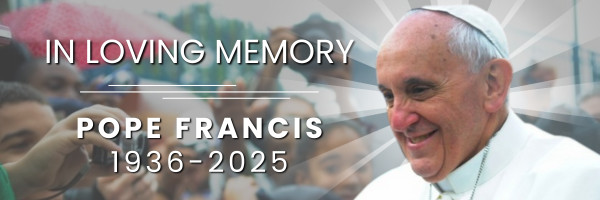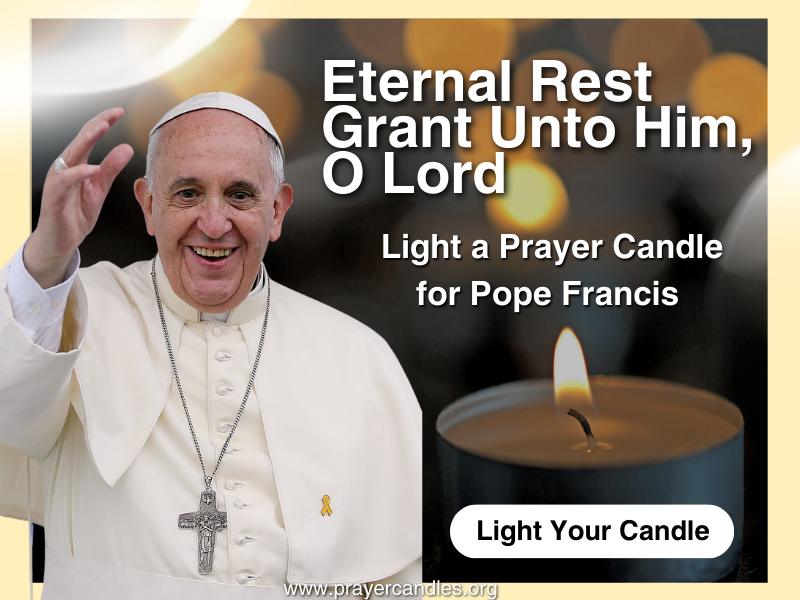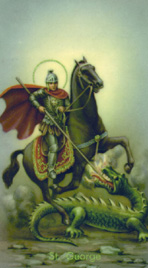 Dear readers, Catholic Online was de-platformed by Shopify for our pro-life beliefs. They shut down our Catholic Online, Catholic Online School, Prayer Candles, and Catholic Online Learning Resources essential faith tools serving over 1.4 million students and millions of families worldwide. Our founders, now in their 70's, just gave their entire life savings to protect this mission. But fewer than 2% of readers donate. If everyone gave just $5, the cost of a coffee, we could rebuild stronger and keep Catholic education free for all. Stand with us in faith. Thank you. Help Now >
Dear readers, Catholic Online was de-platformed by Shopify for our pro-life beliefs. They shut down our Catholic Online, Catholic Online School, Prayer Candles, and Catholic Online Learning Resources essential faith tools serving over 1.4 million students and millions of families worldwide. Our founders, now in their 70's, just gave their entire life savings to protect this mission. But fewer than 2% of readers donate. If everyone gave just $5, the cost of a coffee, we could rebuild stronger and keep Catholic education free for all. Stand with us in faith. Thank you. Help Now >
Divine Mercy Sunday - Healing the Wounds of Our Disbelief
FREE Catholic Classes
I suggest that Thomas was not a doubter, rather he was a believer. And he is a model for all of us at every Eucharist which is always the Feast of Mercy.
His doubts healed the wounds of our own disbelief. They also open - for all who look with the eyes of faith - a deeper understanding of the redemptive effect of the wounds of Jesus - and the role our own wounds can have in our continuing call to conversion as we join them to His. Thomas the doubter became the Thomas the model believer, an example for each one of us. This so-called Doubting Thomas died a martyr for his faith. He became a messenger of Mercy to India, a missionary who shed his own blood for the Master whom he encountered on that day. His insistence on touching the Holy Wounds presented the Disciple John another opportunity to explain for all of us the implications of the Bodily Resurrection of Jesus Christ.

Highlights
The Second Sunday of Easter is Divine Mercy Sunday in the Roman Catholic Liturgical Calendar. The Gospel for the Liturgy (John 20: 19-31) recounts one of the post-Resurrection appearances of Jesus Christ to his disciples. The glorified Jesus appears to his disciples, coming through locked doors and says, "Peace be with you." He breathes upon them the Holy Spirit, creating them anew. He also communicates His authority to forgive sins to the Apostles who will continue His redemptive mission through the Church, which is His Body.
However, Thomas was not present for this encounter. The Beloved disciple John records this exchange between the Risen Lord and Thomas which follows: "Thomas, called Didymus, one of the Twelve, was not with them when Jesus came. So the other disciples said to him, "We have seen the Lord." But he said to them, "Unless I see the mark of the nails in his hands and put my finger into the nail marks and put my hand into his side, I will not believe."
"Now a week later his disciples were again inside and Thomas was with them. Jesus came, although the doors were locked, and stood in their midst and said, "Peace be with you." Then he said to Thomas, "Put your finger here and see my hands, and bring your hand and put it into my side, and do not be unbelieving, but believe." Thomas answered and said to him, "My Lord and my God!"
Jesus bore His Wounds, now glorified, in His Risen Body. Thomas touched those wounds - and so can we, by faith!
This encounter led to Thomas being called Doubting Thomas by some. Yet the tradition tells us that this so-called Doubting Thomas died a martyr for his faith. He became a messenger of Mercy to India, a missionary who shed his own blood for the Master whom he encountered on that day. His insistence on touching the Holy Wounds presented the Disciple John another opportunity to explain for all of us the implications of the Bodily Resurrection of Jesus Christ.
Thomas responds in his beautiful encounter with the Risen Lord - My Lord and My God! That response reveals the heart of prayer. It also speaks to the essence of faith. His proclamation is a call to adoration and a living communion with God. His response has become the exclamation for millions, myself included, when faced with the Mystery of Mysteries, the Holy Eucharist at the elevation during every Mass.
I suggest that Thomas was not a doubter, rather he was a strong believer. And he is a model for all of us at every Eucharist which is always the Feast of Mercy. Pope St Gregory the Great who occupied the Chair of Peter between 590 and 604 preached a marvelous homily on this encounter between Thomas and the Risen Lord. In it he asked:
"What conclusion, dear brethren, do you come to? Surely it was not by chance that this chosen disciple, was missing in the first place? Or that on his return he heard, that hearing he doubted, that doubting he touched, and that touching he believed? It was by divine dispensation and not by chance that things so fell out. The Mercy of God worked wonderfully, for when that doubting disciple touched his Masters wounded flesh he cured the wound of our disbelief. So this doubting disciple, who actually touched, became a witness to the reality of the resurrection."
We Are Instruments of Divine Mercy.We are invited to become living witnesses in our own day to the reality of the Resurrection of Jesus Christ. We are instruments of Divine Mercy. Thomas touched the wounded side of beloved Savior to heal the wounds of our own disbelief. This Sunday we join with Pope Emeritus Benedict XVI, Pope Francis and Catholics throughout the whole world in celebrating the Feast of Divine Mercy.
To Saint Faustina Our Lord said:
"I desire that the Feast of Mercy be a refuge and shelter for all souls, and especially for poor sinners. On that day the very depths of my tender mercy are open. I pour out a whole ocean of graces upon those souls who approach the fount of my mercy."
We are invited to approach the throne of Mercy and cry out with St. Thomas - My Lord and My God (John. 20:28). Those who do so are forever changed. Peter became a messenger of mercy through his encounter with the Risen Lord. He was so filled with the Spirit of the Risen Lord that the Lord could continue His redemptive mission through him, accomplishing miraculous deeds.
In the Acts of the Apostles, the story of the early Church on mission, we read that even the shadow of Peter would effect merciful healing.(Acts 5 12-16) Those who encounter the Risen Jesus are changed, transformed by Mercy made manifest. They then become bearers of mercy for others.
The beloved Disciple John was imprisoned on the Island of Patmos. We can read of his encounter with the Lord in the Spirit in the last book of the Bible. (Rev. 1) He received a merciful vision from the Risen Lord which became the Book of Revelation. In this encounter with the Risen Lord He heard these words:
"Do not be afraid. I am the first and the last, the one who lives. Once I was dead, but now I am alive forever and ever. I hold the keys to death and the netherworld."
And then there was Thomas. His doubts healed the wounds of our own disbelief. They also open up - for all who look with the eyes of faith - a deeper understanding of the redemptive effect of the wounds of Jesus - and the role our own wounds can have in our continuing call to conversion as we join them to His. Thomas the doubter became the Thomas the model believer, an example for each one of us.
This so-called "Doubting Thomas" died a martyr for his faith. He became a messenger of Mercy to India, a missionary who shed his own blood for the Master whom he encountered on that day. His insistence on touching the Holy Wounds presented the Disciple John another opportunity to explain for all of us the implications of the Bodily Resurrection of Jesus Christ.
Jesus turned Thomas' doubt into an event of Mercy for generations to come. Out of a true repentance born from seeing Mercy Incarnate, touching the wounds of His Divine love, came those wonderful words that have formed the most profound of personal prayers for millennia. "My Lord and My God" Pope St Gregory was right, "Thomas' doubt healed the wounds of all of our doubts".
At the Liturgy of Canonization for Sister Mary Faustina Kowalski, Sunday, April 30, 2000, Saint John Paul II proclaimed:
"Before speaking these words, Jesus shows his hands and his side. He points, that is, to the wounds of the Passion, especially the wound in his heart, the source from which flows the great wave of mercy poured out on humanity. From that heart Sr Faustina Kowalska, the blessed whom from now on we will call a saint, will see two rays of light shining from that heart and illuminating the world: "The two rays", Jesus himself explained to her one day, "represent blood and water" Divine Mercy reaches human beings through the heart of Christ crucified and Risen."
"My daughter, say that I am love and mercy personified", Jesus asked of Sr Faustina. Christ pours out this mercy on humanity though the sending of the Spirit who, in the Trinity, is the Person-Love. And is not mercy love's "second name" understood in its deepest and most tender aspect, in its ability to take upon itself the burden of any need and, especially, in its immense capacity for forgiveness? Jesus told St. Faustina: "Humanity will not find peace until it turns trustfully to divine mercy."
St. Faustina Kowalska wrote in her Diary:
"I feel tremendous pain when I see the sufferings of my neighbors. All my neighbors' sufferings reverberate in my own heart; I carry their anguish in my heart in such a way that it even physically destroys me. I would like all their sorrows to fall upon me, in order to relieve my neighbor."
At every Eucharist let us echo these beautiful words of Thomas - My Lord and My God. Let us ask the Lord of Mercy for the grace to become true messengers of Mercy to this age so desperately in need of it.
Thank God for 'Doubting Thomas'. His doubts healed the wounds of our own disbelief. They also open, for all who look with the eyes of faith, a deeper understanding of the redemptive effect of the wounds of Jesus - and the role our own wounds can have in our continuing call to conversion as we join them to His.
Thomas the doubter became the Thomas the model believer, an example for each one of us. On every Feast of Divine Mercy we are invited to echo his marvelous proclamation - My Lord and My God. We also ask that through the intercession of Saint Faustina, that the Lord of Mercy give us each the graces we need to become true messengers of Mercy to an age filled with despair and disbelief.
If you found this content worthwhile, consider helping our educational mission here.
Join the Movement
When you sign up below, you don't just join an email list - you're joining an entire movement for Free world class Catholic education.

Novena for Pope Francis | FREE PDF Download
-

- Stations of the Cross
- Easter / Lent
- 5 Lenten Prayers
- Ash Wednesday
- Living Lent
- 7 Morning Prayers
- Mysteries of the Rosary
- Litany of the Bl. Virgin Mary
- Popular Saints
- Popular Prayers
- Female Saints
- Saint Feast Days by Month
- Pray the Rosary
Who Will Lead the Catholic Church After Pope Francis? A Look at Potential Candidates
Earth Day: 5 Powerful Quotes from Pope Francis on Caring for Creation
The Worst Papal Election in History Has Lessons for Everyone
Daily Catholic
 Daily Readings for Wednesday, April 23, 2025
Daily Readings for Wednesday, April 23, 2025 St. George: Saint of the Day for Wednesday, April 23, 2025
St. George: Saint of the Day for Wednesday, April 23, 2025 Prayer After A Surgery: Prayer of the Day for Wednesday, April 23, 2025
Prayer After A Surgery: Prayer of the Day for Wednesday, April 23, 2025 Daily Readings for Tuesday, April 22, 2025
Daily Readings for Tuesday, April 22, 2025 St. Abdiesus: Saint of the Day for Tuesday, April 22, 2025
St. Abdiesus: Saint of the Day for Tuesday, April 22, 2025- Prayer for Eternal life with God: Prayer of the Day for Tuesday, April 22, 2025
![]()
Copyright 2025 Catholic Online. All materials contained on this site, whether written, audible or visual are the exclusive property of Catholic Online and are protected under U.S. and International copyright laws, © Copyright 2025 Catholic Online. Any unauthorized use, without prior written consent of Catholic Online is strictly forbidden and prohibited.
Catholic Online is a Project of Your Catholic Voice Foundation, a Not-for-Profit Corporation. Your Catholic Voice Foundation has been granted a recognition of tax exemption under Section 501(c)(3) of the Internal Revenue Code. Federal Tax Identification Number: 81-0596847. Your gift is tax-deductible as allowed by law.




 Daily Readings for Wednesday, April 23, 2025
Daily Readings for Wednesday, April 23, 2025 St. George: Saint of the Day for Wednesday, April 23, 2025
St. George: Saint of the Day for Wednesday, April 23, 2025 Prayer After A Surgery: Prayer of the Day for Wednesday, April 23, 2025
Prayer After A Surgery: Prayer of the Day for Wednesday, April 23, 2025 St. Abdiesus: Saint of the Day for Tuesday, April 22, 2025
St. Abdiesus: Saint of the Day for Tuesday, April 22, 2025

